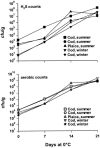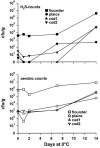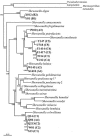Identification of Shewanella baltica as the most important H2S-producing species during iced storage of Danish marine fish
- PMID: 16269698
- PMCID: PMC1287644
- DOI: 10.1128/AEM.71.11.6689-6697.2005
Identification of Shewanella baltica as the most important H2S-producing species during iced storage of Danish marine fish
Abstract
Shewanella putrefaciens has been considered the main spoilage bacteria of low-temperature stored marine seafood. However, psychrotropic Shewanella have been reclassified during recent years, and the purpose of the present study was to determine whether any of the new Shewanella species are important in fish spoilage. More than 500 H2S-producing strains were isolated from iced stored marine fish (cod, plaice, and flounder) caught in the Baltic Sea during winter or summer time. All strains were identified as Shewanella species by phenotypic tests. Different Shewanella species were present on newly caught fish. During the warm summer months the mesophilic human pathogenic S. algae dominated the H2S-producing bacterial population. After iced storage, a shift in the Shewanella species was found, and most of the H2S-producing strains were identified as S. baltica. The 16S rRNA gene sequence analysis confirmed the identification of these two major groups. Several isolates could only be identified to the genus Shewanella level and were separated into two subgroups with low (44%) and high (47%) G+C mol%. The low G+C% group was isolated during winter months, whereas the high G+C% group was isolated on fish caught during summer and only during the first few days of iced storage. Phenotypically, these strains were different from the type strains of S. putrefaciens, S. oneidensis, S. colwelliana, and S. affinis, but the high G+C% group clustered close to S. colwelliana by 16S rRNA gene sequence comparison. The low G+C% group may constitute a new species. S. baltica, and the low G+C% group of Shewanella spp. strains grew well in cod juice at 0 degrees C, but three high G+C Shewanella spp. were unable to grow at 0 degrees C. In conclusion, the spoilage reactions of iced Danish marine fish remain unchanged (i.e., trimethylamine-N-oxide reduction and H2S production); however, the main H2S-producing organism was identified as S. baltica.
Figures




References
-
- Bowman, J. P., S. A. McCammon, D. S. Nichols, J. H. Skerratt, S. M. Rea, P. D. Nichols, and T. A. McMeekin. 1997. Shewanella gelidimarina sp. nov. and Shewanella frigidimarina sp. nov., novel Antarctic species with the ability to produce eicosapentaenoic acid (20:5ω3) and grow anaerobically by dissimilatory Fe(III) reduction. Int. J. Syst. Bacteriol. 47:1040-1047. - PubMed
-
- Bozal, N., M. J. Montes, E. Tudela, F. Jimenez, and J. Guinea. 2002. Shewanella frigidimarina and Shewanella livingstonensis sp. nov. isolated from Antarctic coastal areas. Int. J. Syst. Evol. Microbiol. 52:195-205. - PubMed
-
- Brettar, I., R. Christen, and M. G. Hofle. 2002. Shewanella denitrificans sp. nov., a vigorously denitrifying bacterium isolated from the oxic-anoxic interface of the Gotland Deep in the central Baltic Sea. Int. J. Syst. Evol. Microbiol. 52:2211-2217. - PubMed
-
- Chiniwasagam, H. N., H. A. Bremner, S. J. Thrower, and S. M. Nottingham. 1996. Spoilage pattern of five species of Australian prawns: deterioration is influenced by environment of capture and mode of storage. J. Aquat. Food Prod. Technol. 5:25-50.
-
- Dainty, R. H., R. A. Edwards, C. M. Hibbard, and J. J. Marnewick. 1989. Volatile compounds associated with microbial growth on normal and high pH beef stored at chill temperatures. J. Appl. Bacteriol. 66:281-289. - PubMed
MeSH terms
Substances
Associated data
- Actions
- Actions
- Actions
- Actions
- Actions
- Actions
- Actions
- Actions
- Actions
- Actions
- Actions
- Actions
- Actions
- Actions
- Actions
- Actions
LinkOut - more resources
Full Text Sources
Molecular Biology Databases
Miscellaneous

